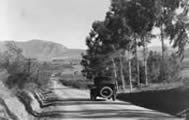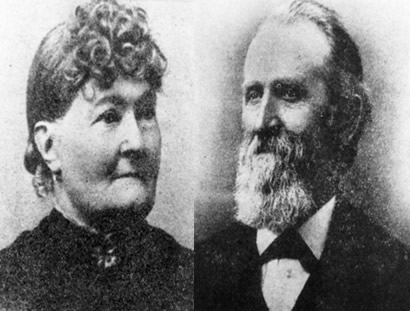- Establishing a more navigable regular stagecoach service from Lakeside to Alpine, Descanso and Cuyamaca--1889.
- Building the Alpine Hotel and a one-room schoolhouse, the Alpine Center School--1890.
- Building the Parsonage--1893.
- Donating land for the Alpine Cemetery on Victoria Drive--1899.
- Forming The Hall Company, Inc., Alpine's first corporation, and donation half of the cost of building the Town Hall.
- Consistently hiring locals. This income was a tremendous help to many local families whose sole support had previously been from their farms and the occasional odd job that came their way.
The Early Years
Benjamin Rice Arnold was born in Kent County, Rhode Island, on September 22, 1822. He is described as 5'8" in height with blue eyes a light complexion and light hair.
His parents, Horatio and Celia (Sheldon) Arnold, were natives of Rhode Island. There were six children in the Arnold family: Mary S., William S., Phoebe, Betsey, Benjamin R. and Dutee.
It has been recorded that the Arnold family is descended from Welsh Kings, dating back to the mid-twelfth century on the paternal side. Benjamin R. Arnold is descended from a well known and respected family who arrived in Massachusetts Bay Colony on June 24, 1635.
William Arnold, head of the family, set out with Roger Williams to a new settlement at Providence Plantation, where he was one of 13 original proprietors. William's name appears frequently in historical records of Providence and the Rhode Island Colony. He held various public offices. His oldest son, Benedict Arnold, was the first Governor of Rhode Island. From this line came the famous General Benedict Arnold, whose betrayal during the Revolutionary War branded him a traitor. Several other descendents of William Arnold held high offices in the colonies and went on to become prominent citizens. Notably, Stephen Arnold, youngest son of William, became Deputy Governor in 1664 and Assistant Governor of Rhode Island in 1667. This is the line from which Benjamin Rice Arnold is descended.
Around 1844, Benjamin R. Arnold engaged in the East African Trade along with his older brother William Sheldon Arnold and their uncle Rufus Green. The firm Rufus Green & Co. was located in Rhode Island and owned several vessels with the capacity of approximately 300 tons. They shipped domestic goods and a general assortment of Yankee notions out of the states. The return cargo would comprise the products of the country. In 1861, the firm established a branch in New York City and five years later it became Arnold, Hines & Co. This firm established a merchant house on the Island of Zanzibar, Africa. After the death of Mr. Hines, the firm became Arnold, Cheney & Co.
Arnold, Cheney & Co. was among the largest importing and shipping firms in this country. Mr. Arnold was active in the ivory trade and his firm was the prime supplier of ivory to Pratt, Reed & Co. of Deep River, Connecticut. This firm was one of two that dominated the manufacture of ivory products in the United States. The products included combs, buttons, billiard balls, toothpicks and piano keys.
Mr. Arnold retired from the New York firm in 1889; however, he remained President of Pratt, Reed & Co. Afflicted with asthma, Mr. Arnold and his wife Harriet moved to San Diego in 1889 hoping the weather would improve his condition. In San Diego, he became interested in real estate. He acquired several lots in the Horton Addition of downtown during the great land boom of 1887 - 1888. He and Mrs. Arnold had a mansion on the corner of 5th and Juniper Streets in downtown San Diego in an area then known as Florence Heights.
The Alpine Years
In 1889 he visited Alpine and found the settlement to his liking. He purchased property in the center of the settlement from Dr. Nugent and began building a large, handsome house. The Arnolds named their home "Los Robles." Dividing time between Alpine and San Diego, the Arnolds maintained both homes for many years. During the busy years of developing the settlement, Mr. Arnold improved the "terrible road" from Lakeside and El Cajon to Alpine. He took over the stage line and made vast improvements to it. He added horses, provided better equipment and increased stage stops. Horses were changed in Alpine, Descanso and Cuyamaca. This stage started from Lakeside a little after 10:00 a.m., picked up the mail and distributed it along the road to the ranches between Lakeside and Alpine. The same thing occurred with the mail in Alpine. Everyone who received mail had to furnish his own sack labeled with his name. The driver delivered them going up and picked them up coming back. The stage carried about eight people. It had a covered top and baggage was tied on the back.
Mr. Arnold's Legacy
Mr. Arnold was responsible for the construction of several public buildings in Alpine. The first was the Alpine Hotel. The hotel's first manager was Mrs. Rose Campbell. Mr. Arnold left the hotel to Mrs. Campbell when he died. He also built the Alpine Center School, a one-room schoolhouse, and the Parsonage. He owned much of the land around the center of Alpine at this time and donated the land for the Alpine Cemetery to the community.
In 1899 Mr. Arnold advanced half the cost to build the Town Hall. The Hall Company, Inc., Alpine's first corporation, was formed with $600 in shares sold to stockholders at $10 per share. Mr. Arnold believed that this approach would ensure that if they helped pay for it the people would have more interest in the Town Hall. This came to pass as the Town Hall soon became the village social and political center.
Mr. Arnold also built the Oak Grove Hotel in Descanso, one of his stage stops. It was here that horses were changed prior to going on to Cuyamaca.
Benjamin Rice Arnold died of heart failure on August 24, 1899 at his home in San Diego. He was buried at the Masonic Cemetery, Mount Hope, in San Diego. At the time of his death, he was considered one of the richest men in Southern California. He owned valuable property in New York City, Providence, Rhode Island, Lakeside, Alpine and Descanso.
Mrs. Arnold died on June 11, 1903 in Rhode Island. That same year, Mr. Arnold's remains were moved to Swan Cemetery in Rhode Island where he is buried next to his wife.
Following is a quote from the book "Alpine: History of a Mountain Settlement" by Beatrice LaForce:
"That he was loved by the people of the
mountain settlement he had adopted is
accepted, and that he loved them and
their village can be assumed by what
he did while here."


